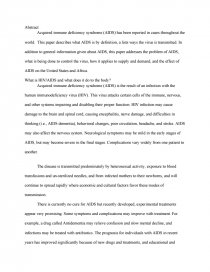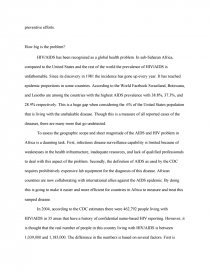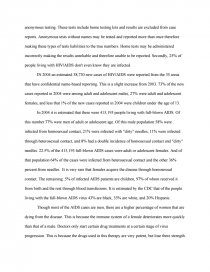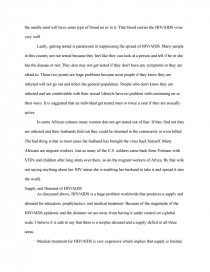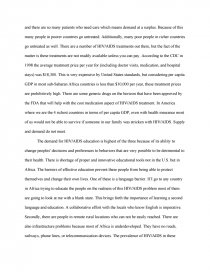Hiv/aids - Africa's Big Problem
Essay by review • February 20, 2011 • Research Paper • 2,276 Words (10 Pages) • 1,737 Views
Abstract
Acquired immune deficiency syndrome (AIDS) has been reported in cases throughout the world. This paper describes what AIDS is by definition, a lists ways the virus is transmitted. In addition to general information given about AIDS, this paper addresses the problem of AIDS, what is being done to control the virus, how it applies to supply and demand, and the effect of AIDS on the United States and Africa.
What is HIV/AIDS and what does it do to the body?
Acquired immune deficiency syndrome (AIDS) is the result of an infection with the human immunodeficiency virus (HIV). This virus attacks certain cells of the immune, nervous, and other systems impairing and disabling their proper function. HIV infection may cause damage to the brain and spinal cord, causing encephalitis, nerve damage, and difficulties in thinking (i.e., AIDS dementia), behavioral changes, poor circulation, headache, and stroke. AIDS may also affect the nervous system. Neurological symptoms may be mild in the early stages of AIDS, but may become severe in the final stages. Complications vary widely from one patient to another.
The disease is transmitted predominately by heterosexual activity, exposure to blood transfusions and un-sterilized needles, and from infected mothers to their newborns, and will continue to spread rapidly where economic and cultural factors favor these modes of transmission.
There is currently no cure for AIDS but recently developed, experimental treatments appear very promising. Some symptoms and complications may improve with treatment. For example, a drug called Antidementia may relieve confusion and slow mental decline, and infections may be treated with antibiotics. The prognosis for individuals with AIDS in recent years has improved significantly because of new drugs and treatments, and educational and preventive efforts.
How big is the problem?
HIV/AIDS has been recognized as a global health problem. In sub-Saharan Africa, compared to the United States and the rest of the world the prevalence of HIV/AIDS is unfathomable. Since its discovery in 1981 the incidence has gone up every year. It has reached epidemic proportions in some countries. According to the World Factbook Swaziland, Botswana, and Lesotho are among the countries with the highest AIDS prevalence with 38.8%, 37.3%, and 28.9% respectively. This is a huge gap when considering the .6% of the United States population that is living with the unshakable disease. Though this is a measure of all reported cases of the diseases, there are many more that go undetected.
To assess the geographic scope and sheer magnitude of the AIDS and HIV problem in Africa is a daunting task. First, infectious disease surveillance capability is limited because of weaknesses in the health infrastructure, inadequate resources, and lack of qualified professionals to deal with this aspect of the problem. Secondly, the definition of AIDS as used by the CDC requires prohibitively expensive lab equipment for the diagnosis of this disease. African countries are now collaborating with international allies against the AIDS epidemic. By doing this is going to make it easier and more efficient for countries in Africa to measure and treat this ramped disease.
In 2004, according to the CDC estimates there were 462,792 people living with HIV/AIDS in 35 areas that have a history of confidential name-based HIV reporting. However, it is thought that the real number of people in this country living with HIV/AIDS is between 1,039,000 and 1,185,000. The difference in the numbers is based on several factors. First is anonymous testing. These tests include home testing kits and results are excluded from case reports. Anonymous tests without names may be tested and reported more than once therefore making these types of tests liabilities to the true numbers. Home tests may be administered incorrectly making the results unreliable and therefore unable to be reported. Secondly, 25% of people living with HIV/AIDS don't even know they are infected.
IN 2004 an estimated 38,730 new cases of HIV/AIDS were reported from the 35 areas that have confidential name-based reporting. This is a slight increase from 2003. 73% of the new cases reported in 2004 were among adult and adolescent males, 27% were adult and adolescent females, and less that 1% of the new cases reported in 2004 were children under the age of 13.
In 2004 it is estimated that there were 415,193 people living with full-blown AIDS. Of this number 77% were men of adult or adolescent age. Of this male population 58% were infected from homosexual contact, 21% were infected with "dirty" needles, 11% were infected through heterosexual contact, and 8% had a double incidence of homosexual contact and "dirty" needles. 22.5% of the 415,193 full-blown AIDS cases were adult or adolescent females. And of that population 64% of the cases were infected from heterosexual contact and the other 36% percent from needles. It is very rare that females acquire the disease through homosexual contact. The remaining .5% of infected AIDS patients are children, 97% of whom received it from birth and the rest through blood transfusions. It is estimated by the CDC that of the people living with the full-blown AIDS virus 43% are black, 35% are white, and 20% Hispanic.
Though most of the AIDS cases are men, there are a higher percentage of women that are dying from the disease. This is because the immune system of a female deteriorates more quickly than that of a male. Doctors only start certain drug treatments at a certain stage of virus progression. This is because the drugs used in this therapy are very potent, but lose there strength after a number of years. On top of that most of the medications have serious unwanted side effects. The doctors typically go by a standard count of 10,000 copies of HIV per milliliter of blood in order to start the therapy. In a study done by Homayoon Farzadegan it was observed that at the point where men and women had comparable deterioration of their immune systems, the women had half as much HIV in their blood as the men did at the same point. Because of this previously undetected difference, and because doctors were treating the patients based on the HIV count in their blood women were being treated in a much later stage than their male counterparts.
What is being done to control the virus?
There are a number of ways to control the HIV/AIDS epidemic. Prevention is the best control for the virus if it has not yet been contracted. First and foremost people must be educated about the disease, what it can do and how to avoid getting or spreading it to and from others.
...
...
